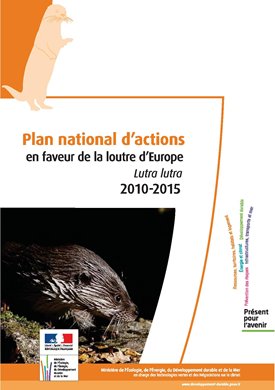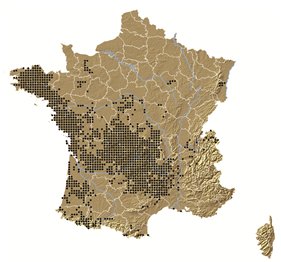IUCN/SSC Otter Specialist Group Bulletin

|
©IUCN/SCC Otter Specialist Group Citation: Kuhn, R., and Jacques, H.. (2011) The French Action Plan For The Eurasian Otter. Proceedings of XIth International Otter Colloquium, IUCN Otter Spec. Group Bull. 28B: 91 - 100 The French Action Plan For The Eurasian Otter Rachel Kuhn1 and Hélène Jacques 1 1Société Française pour l’Etude et la Protection des Mammifères (SFEPM), c/o Muséum d’Histoire Naturelle, Les Rives d’Auron, 18 000 Bourges, France, Tel/Fax: 02 48 70 40 03 Email: loutre.sfepm@yahoo.fr |
| (Received 7th August 2012, accepted 12th September 2012)) |
|
Abstract:A National Action Plan for the Eurasian otter was prepared in 2009 by the French Mammal Society (SFEPM) and is implemented from 2010 until 2015. This project is part of the action plan policy of the French Ministry of Ecology. The first part of the plan is a status report on otter in France and the second part presents the conservation strategy for the next five years. The main issues of the plan are the strengthening of the stakeholder network and the development of cooperation to improve research and conservation, a better circulation of knowledge about otter biology and conservation issues, the implementation of actions to reduce otter mortality, protect and restore otter habitat and increase prey availability and the improvement of cohabitation between otter and aquaculture. |
| Keywords: communication, anthropogenic mortality, habitat conservation, public policy, fish-farming, |
| Française | Español |
INTRODUCTION
In France, the Eurasian otter (Lutra lutra) used to be distributed over the whole country (except Corsica). The population declined sharply during the 20th century because of intensive trapping and destruction of the habitat. Protected since 1972, the otter is now recovering ( Kuhn, 2009 ; Kuhn and Jacques, 2011 ; Lemarchand and Bouchardy, 2011 ). However, this recovery is very slow because of the slow recruitment of the species and the persistence of threats like habitat destruction and road mortality. The otter is still absent from half of the country and is rare in many regions. The parts of the country where the otter is still missing are, in their majority, less suitable (higher human density, higher road traffic, lower ecological quality of the aquatic ecosystems).
The otter has become a flagship species and its popularity could be used to promote aquatic ecosystem conservation projects. In France, the number of local monitoring and conservation projects has increased in the last ten years ( Jacques et al., 2005 ). However, there are discrepancies between regions and sometimes a lack of coordination and communication at a local and national level.
Also, not everybody is happy to see the otter coming back. Indeed fish-farmers are worried because of the damages that otters are sometimes causing on fish-farms ( Leblanc, 2003 ).
For all those reasons, the Ministry of Ecology entrusted the French Mammal Society (SFEPM) with the production of a National Action Plan for the Eurasian Otter ( Figure 1 , 2 , Kuhn, 2009 ).

|

|
| Figure 1: The French Otter Action Plan | Figure 2: Booklet presenting the Action Plan |
| Click images for larger version | |
The main issues of the action plan are:
- Strengthening of the stakeholder network and the development of cooperation to improve research and conservation,
- Better circulation of knowledge about otter biology and conservation issues,
- Implementation of actions to reduce otter mortality, protect and restore otter habitat and increase prey availability,
- Improvement of cohabitation between otter and aquaculture.
The long term goal is the preservation of otter populations and re-colonization of the former home range, under the best possible coexisting conditions with human activities.
Otter distribution in France
In the eighties, the otter survived almost only in the Massif Central and in some parts of the Atlantic coast, which are regions with low human density and/or high food availability. Some small isolated populations also remained, particularly in the north of France. The two main populations started to expand in the nineties and are now joining each other ( Rosoux and de Bellefroid, 2006 ), whereas most of the small isolated populations disappeared ( Figure 3 ). An average re-colonization speed of 3.8 km/year, with maximum values of 10 km/year, was observed in the region Limousin, which is now almost entirely re-colonized ( Dohogne and Leblanc, 2005 ; Leblanc et al., 2005 ).

|
|
Figure 3: Otter distribution in France (Kuhn, 2009). © SFEPM/MNHN. Click for larger version |
The otter also became common in the neighbouring region Auvergne ( Bouchardy, 2001 ). In the region Centre, the otter occurs in more than half of the department of Indre at the foot of the Massif Central ( Dohogne and Rosoux, 2006 ) and expands northwards and also along the river Loire. Actually, the population of the Massif Central expands in all directions. In Rhône-Alpes, the otter is now common in the department of Ardèche and also “reappeared” in the Alps ( Bouché, 2008 ). In the regions Languedoc-Roussillon and Midi-Pyrénées, the otter occurs almost only in the southern part of the Massif Central and in the Pyrénées mountains ( Cassoudebat et al., 2005 ; Defos du Rau et al., 2005 ; Janssens, 2006 ; Janssens et al., 2008 ). The situation is quite unclear in Provence-Alpes-Côte d’Azur where otter occurrence seams to be sporadic ( Mathevet et al., 2005 ).
The otter occurs in many parts of the region Aquitaine but its distribution is apparently scattered. In the north-east of the region, the re-colonization of the department of Dordogne allowed the connection between the Atlantic and the Massif Central population. Northwards, the region Poitou-Charentes is becoming the main “meeting point” between the otters descending from the mountain and those coming from the cost. Otters are abundant in the coastal part of the Pays-de-la-Loire but rare in the rest of the region ( Texier and Varenne, 2009 ). The otter has now re-colonized almost the whole Bretagne except the department of Ile-et-Vilaine ( Simonnet and Caroff, 2009 ). The species also occurs in some islands off the Atlantic coast ( Kuhn, 2001 ; Mercier, 2003 ; Simonnet, 2006 ).
In Basse-Normandie, the small population of the department of Orne not only survived but expanded and began to re-colonize the neighbouring department of Calvados, following the course of the river Orne ( Harivel, 2008 ). A small isolated population holds its ground in Champagne-Ardenne. Remnants of a population are observed in Bourgogne but this region will probably soon be “supplied” with individuals coming from the south ( Varanguin and Sirugue, 2008 ). The otter officially disappeared from the regions Haute-Normandie, Picardie, Nord-Pas-de-Calais, Ile-de-France, Lorraine and Franche-Comté. In Alsace, where the species was also considered extinct, 6 individuals were released between 1998 and 2001 ( Mercier, 2004 ) but this small population probably will not survive.
Needs of the species and conservation strategy
Eurasian otters appear to be more flexible and more able to deal with human disturbances than thought to be. However, they need quiet places to rest and, most of all, to reproduce and raise their young. In places with important human activities, they particularly need good shelter. Food availability appears to be a very important limiting factor for otter populations. Population densities, and so chances to survive and to expand, increase with increasing prey availability. Eurasian otters have a low reproduction rate and a high natural mortality. So the addition of anthropogenic mortality to those natural factors could rapidly be critical. Road mortality appears to be a major threat.
The strategy presented in the action plan is divided into three parts: research, conservation and communication.
Considering the fact that the Eurasian otter is a quite well known species, the research part will be of minor importance, except for:
- Otter monitoring that should be implemented using a standard method in order to update the distribution map regularly,
- Assessment of the potentiality for an area to be suitable for otters,
- Evaluation of the impact of otter predation on fish-farming and research of solutions.
It could be useful to improve the knowledge on sanitary risks (pathologies and impact of pollutants) and also on the effect of some factors (for example disturbance) but with a lower priority because those aspects have been well studied in the past and several other projects are already planed or on their way in France and in other countries. The plan suggests to develop the use of genetic methods and also to study otters in coastal habitat in France, but this is optional.
The plan will concentrate on the “conservation” and “communication” part. Otter conservation first involves a reduction of anthropogenic mortality and also the conservation and restoration of the habitat (particularly prey availability). To achieve this, a better consideration of otter in public policy is necessary. The improvement of ecological status of water bodies required by the Water Framework Directive would benefit otters, in particularly if the species is taken into account while setting priorities. A better use of the Natura 2000 network for otter conservation would also be welcome; the list of Natura 2000 sites where the species occurs has to be updated and the otter must be considered while setting conservation strategies. The principal cause of death, and thus the one that has to be taken into account first, is road mortality. Nevertheless, other causes of mortality (trapping, shooting, fyke-nets, dog bites, etc.) should not be ignored. Ecological corridors could allow a faster re-colonization of some areas and, the most important, a reconnection of isolated populations.
Communication, exchange of information, cooperation (also international cooperation) should be developed. It is also necessary to deepen education of the public and all the stakeholders involved (decision makers, road constructors, dam constructors, fish-farmers, fishermen, anglers, hunters, river managers, outdoor recreation organisers, etc.).
A particular attention should be drawn to the conflict between otter and fish-farming. To handle this problem, it is recommended to compile knowledge on the subject, study otter behaviour around fish-farming facilities, test systems to protect fish-farms, educate fish-farmers and offer them technical and financial help to protect their facilities from otter predation. A national and international network of people working on this problem would be welcome.
Structure of the action plan
The plan, written in 2009, presents the current situation of the Eurasian otter in France, recent projects, organisations working on otters, existing networks and the measures to take for the next 5 years. The plan proposes 31 actions (10 for the category “research”, 10 for the category “conservation” and 11 for the category “communication”). Those actions are aimed to fulfil 5 specific objectives:
- Objective I: Improve the knowledge on the Eurasian otter, its distribution and the re-colonization possibilities and also develop efficient and standardized study methods,
- Objective II: Find solutions to coexisting problems between otter and human activities,
- Objective III: Improve the conservation status, in particular by means of measures to protect/restore the habitat and actions to reduce anthropogenic mortality,
- Objective IV: Inform, train and educate the decision makers, the wetlands and aquatic resources users and the public,
- Objective V: Coordinate the actions and promote cooperation for otter research and conservation, through data centralisation and creation of a network of stakeholders and partners.
Each action is presented in a sheet including a degree of priority (from 1 to 3), the specific objective the action belongs to, the category (research, conservation or communication), the schedule, the context, the objective of the action, a description, the method, links with other actions of the plan, indicators to follow and evaluate the implementation, if possible a cost evaluation, potential partners (technical and financial) and eventually links with other action plans and references. For examples of actions see Table 1 .
Implementation of the action plan
The implementation of the plan has started in autumn 2010. After having written the action plan, the SFEPM was chosen by the Ministry of Ecology to be the operator of the plan. Its mission will be: coordination of the implementation, running of a stakeholder network, communication, centralisation of information, writing of annual reports, fund-raising, etc. A full time position has been opened to coordinate the implementation at a national level. The DREAL Limousin (regional agency of the Ministry of Ecology) supervises the implementation at a local and at a national level on behalf of the Ministry of Ecology who decided to decentralize the national supervision of the action plans. The Limousin, situated in the Massif Central, has been chosen because it is the region with the healthiest otter population in France (almost 100% of the surface covered with signs) and because of its history in otter conservation (e.g. national otter conference in Limoges in 2004, unique experience in France of protecting fish-farms from predation by otters, etc.).
Also, a National Steering Committee (Comité de Pilotage National) follows and evaluates the implementation and validates the decisions. This committee is made of representatives of the Ministry of Ecology, Ministry of Agriculture, DREALs, MNHN (National Natural History Museum), ONCFS (French national agency for hunting and wildlife), ONEMA (French national agency for water and aquatic environments), ONF (National forest agency), nature reservations and parks, nature conservation organisations, scientists, road constructors, fishermen, anglers, fish-farmers, hunters, canoeing federation and others. The members of this committee meet once a year. The implementation gets financial support from the Ministry of Ecology but additional funds have to be raised. Each DREAL is responsible of the implementation in its region. Local organisations are invited to submit projects in accordance with the action plan. A couple of documents and communication tools (technical reports, flyers, exhibition…) on different topics (otter biology, habitat conservation, road traffic, fish-farming…) and for different target audience (public, decision-makers, road constructors, fish-farmers, river managers…) will be provided by the operator.
The plan and information about the implementation can be downloaded from our website http://www.sfepm.org/pdf/PNALoutre.pdf and http://www.sfepm.org/planloutre.htm.
ACKNOWLEDGMENTS -Special recognition must be given to all the people who participated in the writing and editing of the action plan and, of course, to all those who participate in its implementation. Many thanks to François Moutou for proofreading this manuscript.
REFERENCES
Bouchardy, C. (2001). La loutre d’Europe, histoire d’une sauvegarde. Catiche Productions/Libris. 32 pp.
Bouché, J.
(2008). Loutre d’Europe Lutra lutra en Rhône-Alpes: point sur les observations en 2008 et contribution à l’actualisation de sa répartition en 2003-2007. Le Bièvre
22: 5-15.
Cassoudebat, L., Martin, S., Molinier, A., Tessier, M., Bertrand, A.
(2005). Statut et conservation de la Loutre (Lutra lutra) en région Midi-Pyrénées. Arvicola 17: 9-16.
Defos Du Rau, P., Cano, S., Doukhan, G., Gomes, R., Gonzalez, E., Lacout, P. (2005). Contribution à l’actualisation des connaissances sur la répartition de la Loutre d’Europe en région Midi-Pyrénées. La Conservation de la Loutre, actes du XXVIIème Colloque Francophone de Mammalogie de la SFEPM: 63-70.
Dohogne, R., Leblanc, F.
(2005). Actualisation de la répartition de la Loutre d’Europe (Lutra lutra) en Limousin. Rapport GMHL. 80 pp.
Dohogne, R., Rosoux, R. (2006). La Loutre (Lutra lutra) dans le département de l’Indre, évolution du statut et répartition actuelle. Symbiose
16: 55-59.
Harivel, R. (2008). Etude de la répartition de la Loutre d’Europe (Lutra lutra) sur l’Orne et ses affluents (14-61). Rapport CPIE des Collines Normandes. 16 pp (+ annexes).
Jacques, H., Leblanc, F., Moutou, F. (Eds.) (2005). La Conservation de la Loutre, actes du XXVIIème Colloque Francophone de Mammalogie de la SFEPM, Limoges, 2004. SFEPM/GMHL. 199 pp.
Janssens, X. (2006). Monitoring and predicting elusive species colonisation: application to the otter in the Cévennes National Park (France). Thèse de Doctorat. Université catholique de Louvain. Louvain.
Janssens, X., Fontaine, M.C., Michaux, J.R., Libois, R., De Kermabon, J., Defourny, P., Baret, P.V. (2008). Genetic pattern of the recent recovery of European otters in southern France. Ecography 31: 176-186.
Kuhn, R.A. (2001). Etude de l’occupation et de l’utilisation des ressources trophiques de deux milieux côtiers de la façade atlantique par la Loutre d’Europe (Lutra lutra) : la Baie de l’Aiguillon et l’Ile d’Oléron (France). Mémoire de DES. Unité de Recherches Zoogéographiques, Université de Liège. Liège.
Kuhn, R. (2009). Plan National d'Actions pour la Loutre d'Europe (Lutra lutra), 2010-2015. SFEPM/MEEDDM. 110 pp.
Kuhn, R., Jacques, H. (2011). La Loutre d’Europe. Encyclopédie des Carnivores de France. SFEPM, 72 pp.
Leblanc, F. (2003). Protecting Fish Farms from Predation by the Eurasian Otter (Lutra lutra) in the Limousin region of Central France: First Results.
IUCN Otter Specialist Group Bull
. 20
: 45-48.
Leblanc, F., Dohogne, R., Guischer, V., Thuaire, N., Bellanger, C., Constant, J. (2005). Actualisation de la répartition de la Loutre d’Europe en Limousin (2003/2004). La Conservation de la Loutre, actes du XXVIIème Colloque Francophone de Mammalogie de la SFEPM: 9-28.
Lemarchand, C., Bouchardy, C. (2011). La loutre d’Europe, histoire d’une sauvegarde. Catiche Productions, 32 p.
Mathevet, R., Olivier, A., Lucches, J.-L. (2005). La Loutre d’Europe dans le Grand Delta du Rhône: historique et perspectives. La Conservation de la Loutre, actes du XXVIIème Colloque Francophone de Mammalogie de la SFEPM: 47-54.
Mercier, L. (2003). Régime alimentaire de la Loutre, Lutra lutra, sur l’île de Noirmoutier (Vendée). Le Naturaliste Vendéen, 3 121-131.
Mercier, L. (2004). Bilan de la réintroduction de la Loutre Lutra lutra (Linné, 1758) en Alsace, France. Bull. Soc. Hist. nat. Colmar
65: 117-134.
Rosoux, R., De Bellefroid, M.N. (2006). Le retour de la loutre en France. Symbiose
16: 60-62.
Simonnet, F. (2006). Loutre d’Europe, la reconquête des rivières. Eau et Rivières de Bretagne, supplément spécial, octobre 2006: 14-17.
Simonnet, F., Caroff, C. (2009). Contrat-Nature, Mammifères Semi-aquatiques de Bretagne. Bilan 2005-2008. Rapport GMB. 33 pp (+ annexes).
Texier, A., Varenne, F. (2009). La Loutre d’Europe. In: Mammifères, Amphibiens et Reptiles prioritaires en Pays de la Loire. Marchadour, B. (Ed): 50-51 pp. Coordination régionale LPO Pays de la Loire/Conseil Régional des Pays de la Loire.
Varanguin, N., Sirugue, D. (2008). Vers une reconquête des rivières par la Loutre en Bourgogne. Bourgogne-Nature
8: 205-227.
Résumé : Le Plan National d’Actions en Faveur de la Loutre d’Europe
Le Plan National d’Actions en faveur de la Loutre d’Europe a été rédigé par la Société Française pour l’Etude et la Protection des Mammifères (SFEPM) en 2009 et est mis en œuvre de 2010 à 2015. La première partie du plan présente un état des lieux et la deuxième partie définit la stratégie de conservation pour les cinq années à venir. Les principaux objectifs du plan sont la consolidation du réseau d’acteurs et le développement des coopérations pour améliorer la recherche et la conservation, une meilleure circulation de l’information sur la biologie de la Loutre et les problématiques liées à sa conservation, la mise en œuvre d’actions de conservation pour réduire la mortalité, protéger et restaurer l’habitat de la Loutre et améliorer la disponibilité des ressources alimentaires, et l’amélioration des conditions de cohabitation entre la Loutre et l’aquaculture.
Revenez au dessus
Resumen: El Plan de Acción Francesa para la Lutra lutra
En 2009, la Sociedad para los Mamíferos de Francia preparó un Plan Nacional de Acción para la Nutria Eurasiática; para ser implementado de 2010 a 2015. Este proyecto es parte de una política de planes de acción del Ministerio de Ecología de Francia. La primera parte del plan es un informe del estatus de la nutria en Francia, y la segunda parte presenta la estrategia de conservación para los próximos cinco años. Los principales aspectos del plan son el fortalecimiento de la red de actores involucrados y el desarrollo de la cooperación para mejorar la investigación y la conservación, una mejor circulación del conocimiento acerca de la biología de la nutria y sus problemas de conservación, la implementación de acciones para reducir la mortalidad de nutrias, proteger y restaurar el hábitat de las nutrias e incrementar la disponibilidad de presas, y el mejoramiento de la coexistencia entre la nutria y la acuicultura.
Vuelva a la tapa

